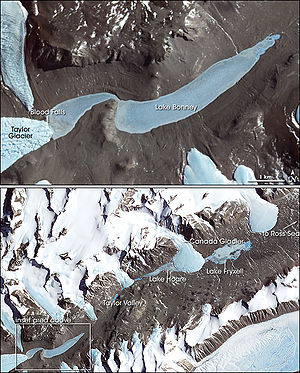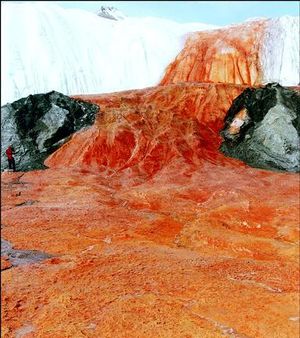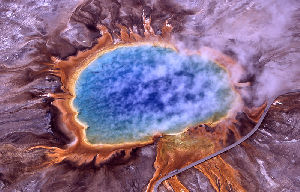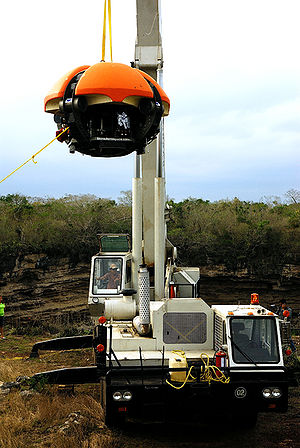Blood Falls, Antarctica: Difference between revisions
No edit summary |
|||
| Line 6: | Line 6: | ||
==Physical environment== | ==Physical environment== | ||
===Subsection 1=== | ===Subsection 1=== | ||
==== | ====Temperature==== | ||
The average temperature at the area of Blood Falls is -20<sup>O</sup> C. | |||
====Precipitation==== | |||
The average moisture at the area of Blood Falls is less than six mm of water units. These dry conditions have persisted in the area for about fifteen million years. | |||
====Species Richness & Diversity==== | |||
====Temperature==== | |||
====Temperature==== | |||
====Subsection 1b==== | ====Subsection 1b==== | ||
====Species Richness & Diversity==== | |||
===Subsection 2=== | ===Subsection 2=== | ||
==Biological interactions== | ==Biological interactions== | ||
Revision as of 03:42, 10 April 2010
Introduction
Blood Falls, Antarctica is a subglacier outflow that hosts a habitat of microbes. The subglacier outflow has iron in the outflow which results in the outflow appearing to being “blood like,” or a deep red. The microbes that survive in Blood Falls are some of the most versatile organisms on the planet as they can survive without oxygen, using iron and sulfate to survive. As these microbes survive without oxygen, an important process for these microbes are that they are evidence of possible how possible life outside of earth would survive.


Physical environment
Subsection 1
Temperature
The average temperature at the area of Blood Falls is -20O C.
Precipitation
The average moisture at the area of Blood Falls is less than six mm of water units. These dry conditions have persisted in the area for about fifteen million years.
Species Richness & Diversity
Temperature
Temperature
Subsection 1b
Species Richness & Diversity
Subsection 2
Biological interactions
Subsection 1
Subsection 1a
Subsection 1b
Subsection 2
Microbial processes
Key Microorganisms
Several types of microbes in this habitat are that the microbes are psychrophilic, chemoautotrophically or chemoorganotrophically. The microbes in this habitat survive by harvesting energy from bedrock minerals or the assemblage may grow heterotrophically on ancient marine organics by respiring Fe(III) or SO42_.
Energy Sources
The energy sources that the microbes use in this habitat are chemoautotrophics, chemoorganotrophics and heterotrophs.
Chemoautotrophs
Organisms that are chemoautotrophs are organisms, such as a bacterium that obtains its nourishment through the oxidation of inorganic chemical compounds as opposed to photosynthesis. [5]
Chemoorganotrophs
Organisms that are Chemoorganotrophs utilize organic compounds as their energy source. [6]
Heterotrophs
Organisms that are Heterotrophs are organisms that can’t synthesize its own food and is dependent on complex organic substances for nutrition and survival. [7]
Extremophiles
Organisms that are extremophile is an organism that thrives in and may even require physically or geochemically extreme conditions that are detrimental to the majority of life on Earth. [8]

Psychrophiles
Organisms that are Psychrophiles are organisms that are capable of growth and reproduction in cold temperatures. [9]
Special Adaptations
Chemoautotrophs in Blood Falls, are able to live by breathing iron leached from bedrock with the help of a sulfur catalyst. [10]
Examples of organisms within the group
Thiomicrospira arctica
Betaproteobacteria
Deltaproteobacteria
Gammaproteobacteria
Current Research
Snowball Earth Theory
The discovery of the microbes at Blood Falls, the microbes were found in a place where cold, darkness, and lack of oxygen previously have led scientists to believe nothing could survive at Blood Falls. [11] The discovery of microbes surviving here without using oxygen has given the supporters of the hypothesis of the “Snowball Earth” a key piece of evidence. Stephen Warren is leading an expedition to Antarctica to study the Antarctic ice to study the past climate of the earth. [12]
Life on Other Planetary Bodies
In addition to how the microbes can survive without using Oxygen, research has been started to determine if life can exist outside of Earth under ice, for example at Mars or Europa, a moon of Jupiter. The first step in this research is called Environmentally Non-Disturbing Under-ice Robotic ANtarctiC Explorer (ENDURANCE). This research will help scientists determine what the ocean looks like underneath the Antarctic ice sheet. [13]

Jill A. Mikucki and John C. Priscu Research
Jill A. Mikucki and John C. Priscu conducted a research at Blood Falls that determined the bacterial diversity in Blood Falls the research was designed to be able to validate other researches that determined that the subglacier brine was a host of microbes with using Iron and Sulfate concentrations. The results of this research determined that the brine underneath the ice held a viable ecosystem of microbes that can grow using reduced iron and sulfur compounds. [14]
References
1.
2.
3.
4.
5.
6.
7.
8.
9.
10.
11.
12.
13.
Edited by student of Angela Kent at the University of Illinois at Urbana-Champaign.
